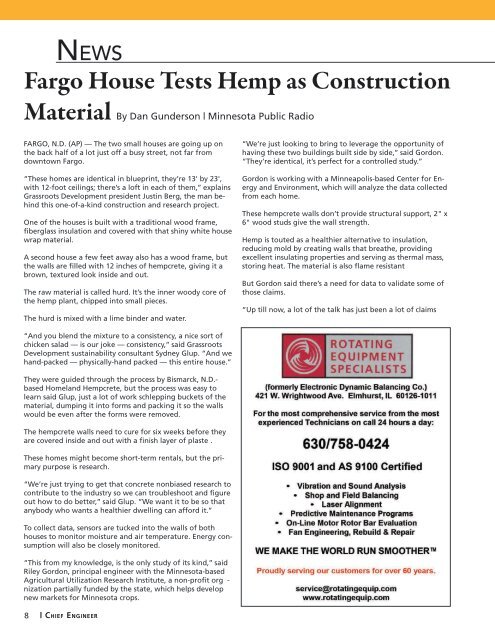CEAC-2022-09-September
Create successful ePaper yourself
Turn your PDF publications into a flip-book with our unique Google optimized e-Paper software.
News<br />
Fargo House Tests Hemp as Construction<br />
Material By Dan Gunderson | Minnesota Public Radio<br />
FARGO, N.D. (AP) — The two small houses are going up on<br />
the back half of a lot just off a busy street, not far from<br />
downtown Fargo.<br />
“These homes are identical in blueprint, they’re 13' by 23',<br />
with 12-foot ceilings; there’s a loft in each of them,’’ explains<br />
Grassroots Development president Justin Berg, the man behind<br />
this one-of-a-kind construction and research project.<br />
One of the houses is built with a traditional wood frame,<br />
fiberglass insulation and covered with that shiny white house<br />
wrap material.<br />
A second house a few feet away also has a wood frame, but<br />
the walls are filled with 12 inches of hempcrete, giving it a<br />
brown, textured look inside and out.<br />
The raw material is called hurd. It’s the inner woody core of<br />
the hemp plant, chipped into small pieces.<br />
The hurd is mixed with a lime binder and water.<br />
“We’re just looking to bring to leverage the opportunity of<br />
having these two buildings built side by side,’’ said Gordon.<br />
“They’re identical, it’s perfect for a controlled study.’’<br />
Gordon is working with a Minneapolis-based Center for Energy<br />
and Environment, which will analyze the data collected<br />
from each home.<br />
These hempcrete walls don’t provide structural support, 2" x<br />
6" wood studs give the wall strength.<br />
Hemp is touted as a healthier alternative to insulation,<br />
reducing mold by creating walls that breathe, providing<br />
excellent insulating properties and serving as thermal mass,<br />
storing heat. The material is also flame resistant<br />
But Gordon said there’s a need for data to validate some of<br />
those claims.<br />
“Up till now, a lot of the talk has just been a lot of claims<br />
“And you blend the mixture to a consistency, a nice sort of<br />
chicken salad — is our joke — consistency,’’ said Grassroots<br />
Development sustainability consultant Sydney Glup. “And we<br />
hand-packed — physically-hand packed — this entire house.’’<br />
They were guided through the process by Bismarck, N.D.-<br />
based Homeland Hempcrete, but the process was easy to<br />
learn said Glup, just a lot of work schlepping buckets of the<br />
material, dumping it into forms and packing it so the walls<br />
would be even after the forms were removed.<br />
The hempcrete walls need to cure for six weeks before they<br />
are covered inside and out with a finish layer of plaste .<br />
These homes might become short-term rentals, but the primary<br />
purpose is research.<br />
“We’re just trying to get that concrete nonbiased research to<br />
contribute to the industry so we can troubleshoot and figure<br />
out how to do better,’’ said Glup. “We want it to be so that<br />
anybody who wants a healthier dwelling can afford it.’’<br />
To collect data, sensors are tucked into the walls of both<br />
houses to monitor moisture and air temperature. Energy consumption<br />
will also be closely monitored.<br />
“This from my knowledge, is the only study of its kind,’’ said<br />
Riley Gordon, principal engineer with the Minnesota-based<br />
Agricultural Utilization Research Institute, a non-profit org -<br />
nization partially funded by the state, which helps develop<br />
new markets for Minnesota crops.<br />
8<br />
| Chief Engineer<br />
<strong>09</strong>22 issue.indd 8 8/22/22 3:27 PM
















